The Qualcomm Snapdragon 820 Performance Preview: Meet Kryo
by Ryan Smith & Andrei Frumusanu on December 10, 2015 11:00 AM EST- Posted in
- SoCs
- Snapdragon
- Qualcomm
- Snapdragon 820
GPU Performance
Shifting gears, let’s take a look at GPU performance. As we mentioned earlier, Qualcomm isn’t disclosing much about this GPU other than that it packs quite a bit more computational power than its predecessor and should be quite a bit faster in the process. This points to a potentially significant architectural shift, but that determination will have to wait for another time.
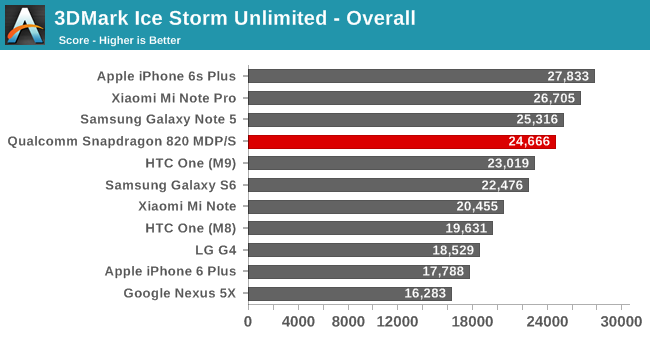

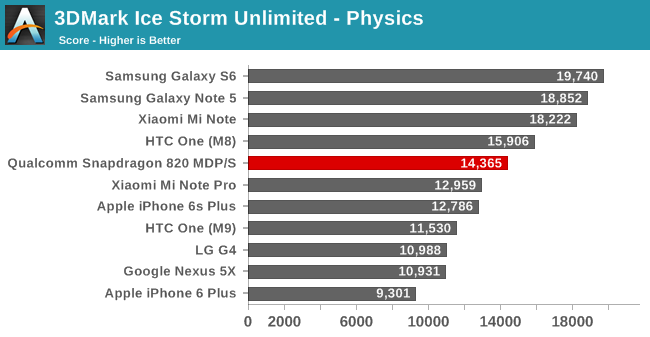
Starting with 3DMark Ice Storm Unlimited, the performance honestly doesn’t start out great. The overall score is significantly influenced by the physics score, which in turn is more concerned with the number of cores and their throughput on simple code than the ability to extract complex IPC. As a result the 4 CPU core 820 simply can’t catch up with the likes of the Samsung devices and their high-clocked big.LITTLE configurations. On the other hand the graphics score makes this the fastest Android phone to date, though relative to the 810 Mi Note Pro, perhaps not by a ton. Ultimately as this is an OpenGL ES 2.x test it’s not the most strenuous of tests these days, and comments from Qualcomm indicate that it may be a CPU-limited test on 820.
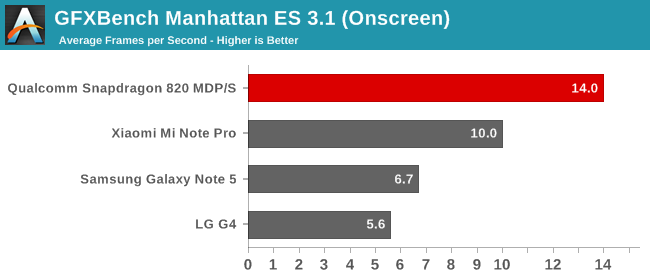
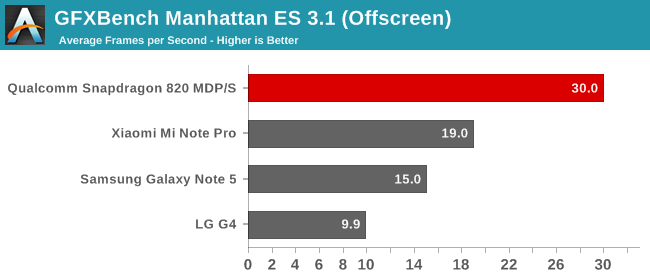
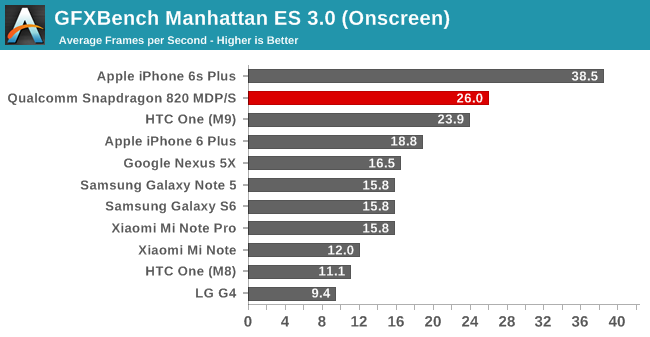
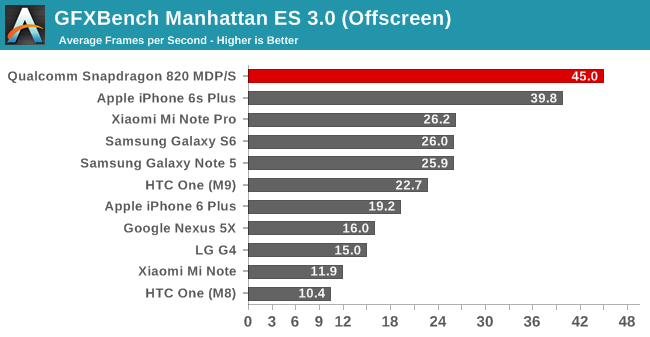
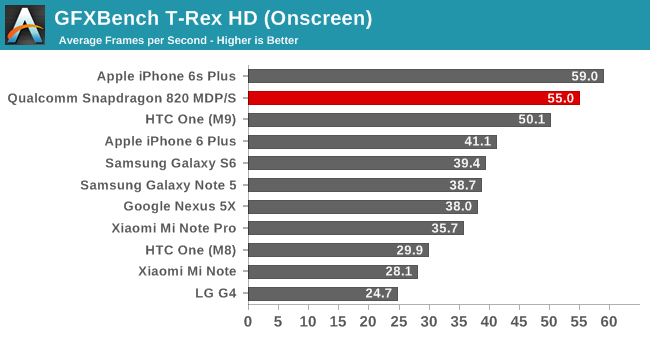

GFXBench on the other hand shows some massive gains for the 820 relative to any other Android device. In offscreen rendering mode, all 3 game tests – Manhattan ES 3.1, Manhattan ES 3.0, and T-Rex HD – put the 820 MDP/S as being 52% (or more) faster than the next-fastest Android device, either the 810 based Mi Note Pro or the Exynos 7420 based Samsung Galaxy Note 5. The single biggest jump we see is with Manhattan ES 3.0 at 72%, while the ES 3.1 version dials that back down to 52%. Even the iPhone 6s Plus, well known for its powerful GPU, is handily and consistently surpassed by the 820 here. Only due to the 6s Plus’s lower rendering resolution of 2208x1242 does it surpass the MDP/S in onscreen tests, as the latter needs to render at 2560x1600 (~50% more pixels). Qualcomm was aiming for some big GPU performance gains here and so far they are delivering.
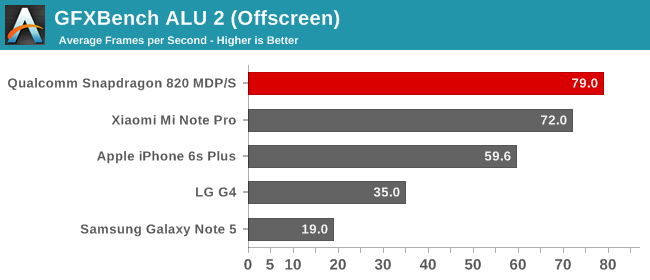
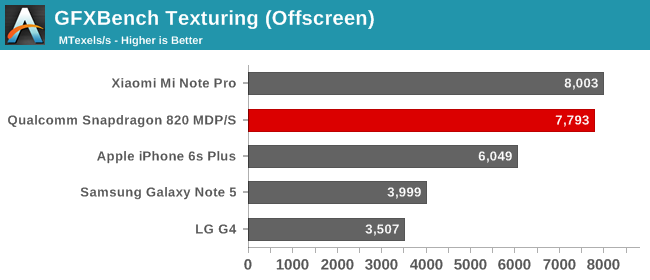
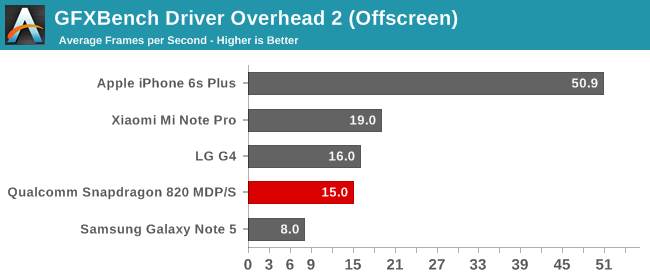
Curiously, GFXBench’s synthetic feature tests don’t show the same gains. Offscreen ALU performance is only slightly improved over the 810 (10%) or in the case of texturing is an outright regression. None-the-less full gaming performance is clearly in the 820’s favor. I’ve long suspected that the Adreno 430 GPU in the 810 had some kind of architectural bottleneck – perhaps an ALU/texture array that was difficult to fully utilize – and what we’re seeing here would back up that claim, as if that was the case then correcting it would have allowed Qualcomm to significantly boost their rendering performance while only barely changing their synthetic performance. Otherwise I find it a bit surprising that the driver overhead score is a bit worse on 820 than 810, which may be a result of the immature GPU drivers on this early device.










146 Comments
View All Comments
kspirit - Thursday, December 10, 2015 - link
What are the chances this shows up in the Galaxy S7? Because let's be honest, a large reason of Qualcomm's drop in revenue is because Samsung is sticking to their own chips now. But the 820 looks interesting indeed.Clayevans - Thursday, December 10, 2015 - link
Probably better than the chance that this will show up in the iPhone 7, haha. But in all seriousness, I think everyone would be very surprised to see Sammy switch back. Any specific guesses on my part would be pure BS.close - Friday, December 11, 2015 - link
It will probably use multiple sourcing like other models do. So Samsung may sell enough phones to have the need to also source SoCs from Qualcomm. Also Samsung sells their Exynos SoC to other vendors so the entire production is not dedicated for internal use.frostyfiredude - Sunday, December 13, 2015 - link
There are a lot of complaints of network issues because of the S6's Shannon modem, in NA especially on both the operator and client sides; a return to the previous method of doing US/Canada with Qualcomm and everyone else Exynos seems likely for that reason. Especially since S820 seems quite decent.jjj - Thursday, December 10, 2015 - link
The rumors were that Qualcomm gets the CDMA carriers while everything else,including international unlocked version, is Exynos.Samsung would save a lot of money with their own SoC so they would use something else only if there was a very good reason to. The perf here doesn't seem like a good enough reason.
Clayevans - Thursday, December 10, 2015 - link
I remember back in the early days of Exynos, the USA galaxy phones would get snapdragon simply because Sammy couldn't produce enough of their own to cover global demand. They don't have that problem anymore. And like you said, there really aren't any compelling reasons for them to go back to Snapdragon that would justify the cost.jjj - Thursday, December 10, 2015 - link
In fairness the CPU perf is great, sure it doesn't seem like it will crush A72 but compared to SD801 the perf is fantastic - SD810 was terrible so can be ignored.In Geekbench in integer and FP it's over 2x the SD801 in single core and that's insane in a phone.That's why a comparison with older desktop cores would be nice. CPU perf is clearly hitting good enough in phones.
The memory perf is stupid good here.
2016 is exciting, what SoC wins doesn't really matter, we the users certainly win.
mmrezaie - Thursday, December 10, 2015 - link
How can you say performance is great?! It is actually at best as good as A72 performances reported so far, and not even on a same node size. So what was all the reason behind research and development when you build something as good as ARM's offering. No wonder other companies feel safe using ARM for their SOCs. I don't think samsung will go for this if they can manufacture their SOC in time.ddriver - Thursday, December 10, 2015 - link
Judging from the name, it will take Kryogenic cooling to really shine ;)BurntMyBacon - Monday, December 14, 2015 - link
@ddriver: "Judging from the name, it will take Kryogenic cooling to really shine ;)"Oh. I thought it meant that kryotic was used in the manufacturing process. ;')
Thanks for clearing that up.